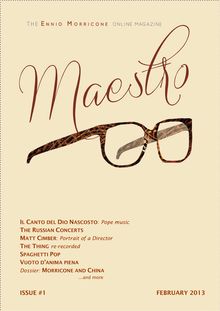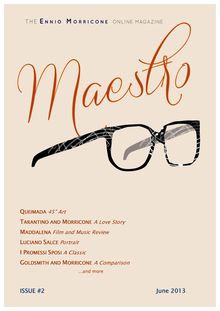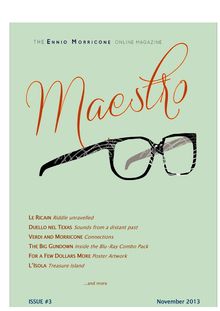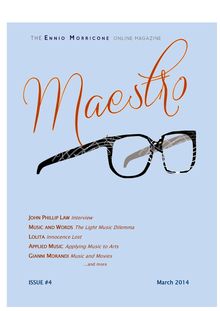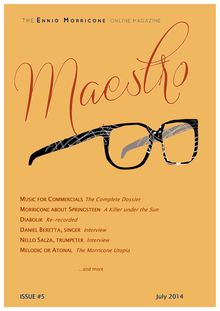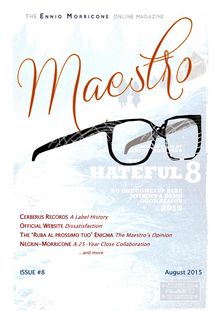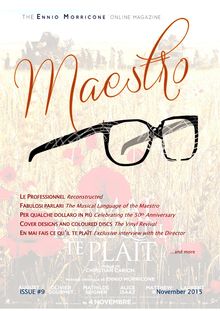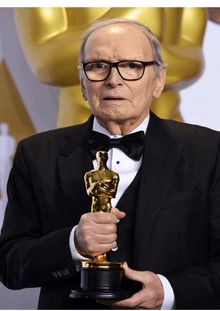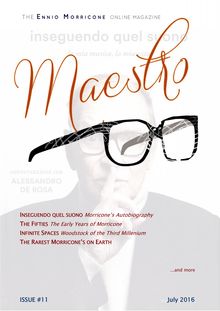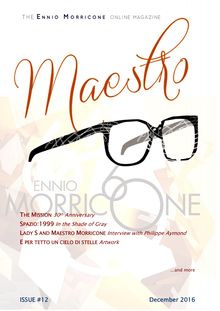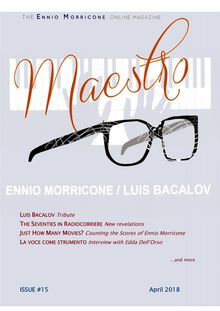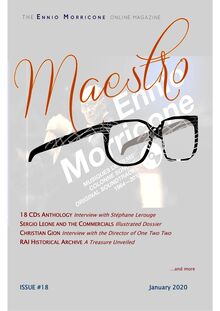-
 Univers
Univers
-
 Ebooks
Ebooks
-
 Livres audio
Livres audio
-
 Presse
Presse
-
 Podcasts
Podcasts
-
 BD
BD
-
 Documents
Documents
-
- Cours
- Révisions
- Ressources pédagogiques
- Sciences de l’éducation
- Manuels scolaires
- Langues
- Travaux de classe
- Annales de BEP
- Etudes supérieures
- Maternelle et primaire
- Fiches de lecture
- Orientation scolaire
- Méthodologie
- Corrigés de devoir
- Annales d’examens et concours
- Annales du bac
- Annales du brevet
- Rapports de stage
La lecture à portée de main
53 pages
English
Maestro, the Ennio Morricone Online Magazine, Issue #1 - February 2013
Le téléchargement nécessite un accès à la bibliothèque YouScribe
Tout savoir sur nos offres
Tout savoir sur nos offres
53 pages
English
Le téléchargement nécessite un accès à la bibliothèque YouScribe
Tout savoir sur nos offres
Tout savoir sur nos offres

Description
PREFACE – Primo - Patrick Bouster (3,4) -- DVD REVIEW - Il canto del dio nascosto: Il papa buono, il papa brutto, il papa cattivo - Didier Thunus (5-8) -- ANALYSIS - Spaghetti Pop - Steven Dixon (8-14) -- CONCERT REVIEWS - The Russian Concerts - Eldar Djabrailov (14-19) -- DOSSIER - Pomp and Circumstance: Morricone, the right composer for all solemn occasions (Part I) - Laurent Perret (19-27) -- CONCERT REVIEW - Vuoto d’anima piena: Mill’Ennio - Patrick Bouster (28-30) -- CD REVIEW - The Thing, the Strings and the Synths - Didier Thunus (31-34) -- DOSSIER - Ennio Morricone and China (Part I) - Wenguang Han (35-45) -- VINTAGE - Geoff Love "La Musique D'Ennio Morricone" - Steven Dixon (46-47) -- PORTRAIT - Vengeance of the Butterfly: Morricone and Matt Cimber - Gergely Hubai (48-51) -- ALBUM REVIEW - Ultimo: L’occhio del falco - Patrick Bouster (51-54)
Sujets
Informations
| Publié par | didier_thunus |
| Publié le | 28 octobre 2015 |
| Nombre de lectures | 43 |
| Licence : |
En savoir + Paternité, pas d'utilisation commerciale, partage des conditions initiales à l'identique
|
| Langue | English |
| Poids de l'ouvrage | 15 Mo |
Extrait
ILCANTO DELDIONASCOSTO:Pope musicTHERUSSIANCONCERTSMATTCIMBER:Portrait of a DirectorTHETHINGre-recordedSPAGHETTIPOPVUOTO D’ANIMA PIENADossier:MORRICONE ANDCHINA ...and more ISSUE #1
FEBRUARY 2013
MAESTRO–THEENNIOMORRICONEONLINEMAGAZINE
ISSUE#1
JANUARY2013
Primo .......................................................................................................................................... 3 Il canto del dio nascosto ............................................................................................................. 5 Spaghetti Pop.............................................................................................................................. 8 The Russian Concerts ............................................................................................................... 14 Pomp and Circumstance........................................................................................................... 19 Vuoto d’anima piena ................................................................................................................ 28 The Thing, the Strings and the Synths ..................................................................................... 31 Ennio Morricone and China ..................................................................................................... 35 Geoff Love ............................................................................................................................... 46 Vengeance of the Butterfly ...................................................................................................... 48 Ultimo: L’occhio del falco ....................................................................................................... 51
License for all articles : CreativeCommons Cette œuvre est mise à disposition selon les termes de la Licence Creative Commons Attribution - Pas d’Utilisation Commerciale - Partage dans les Mêmes Conditions 2.0 Belgique Cover design by Valeria Magyar
2
MAESTRO–THEENNIOMORRICONEONLINEMAGAZINE
ISSUE#1
--------------PREFACE--------------
Primo
by Patrick Bouster
JANUARY2013
So here we are, after the compliments and thanks to Martin Van Wouw for MSV and the work until the issue number 116. This on-line magazine is born through the idea I proposed that it would be impossible to have nothing after MSV about a major composer as Ennio Morricone is. Note that there no longer exists a paper magazine nor an on-line one about any film composer. The webmaster of chimai.com since the year 2002, Didier Thunus (47 y.o., from Belgium), shared this idea and agreed to launch it with me and to host the files to download. As for me (48 y.o., from France), I collect Morricone’s music since 1982, and contributed for MSV since 1998, and sparsely before. Soon after the announcement in the forum, here is the first issue, with fortunately known names : Laurent Perret, Steven Dixon, Didier Thunus, and myself. We are happy to gather with new people : Eldar Djabrailov (a young passionate man from Kazakhstan), Gergely Hubai (from Hungary, author of the book “Torn Music”), and Wenguang Han (webmaster of the Chinese website). The absence of the Italian people, already for MSV since some years, shouldn’t be a surprise : artists are better appreciated outside their countries. We will keep the main principle to built a periodical document, containing dossiers, reviews, in-depth articles, discoveries and free comments. But considering the internet phenomenon, exhaustive reviews on actuality and the “technicalities” (list of CDs published) seem to us redundant and useless. We wish to be complementary to the internet with articles and dossiers never found elsewhere. The shape changed with the A4 format, a more comfortable size, practical to print (the goal is mainly to read easily on paper and to keep it), with a table of contents, more pictures, in colors, and … for free. An on-line document, through a registration at chimai.com, not by chance, it coincides exactly with the spectacular increase of the download process for Morricone’s new soundtracks with La migliore offerta and Ultimo – l’occhio del falco. In a world disturbed by money, speculation, financial troubles for numerous families, there is a great satisfaction to produce a work by pleasure, for free. We give the best of ourselves, asking nothing in return. Only a true and simple joy, with some pride, to make something for Morricone’s music memory and knowledge. The word free also implies “liberty”, independence. As the website chimai.com is “unofficial” and not directly linked to EM’s interests, the magazine is created to have an autonomy, to be sometimes critical, if we wish to be useful and pertinent. Furthermore the coherence with other elements linked to Ennio Morricone’s music is the closeness to both the chimai.com and the forum enniomorrricone.it/forum sites, confirming an idea of a “general space” dedicated to EM I proposed in MSV two years ago. Free to affirm that art is superior to material aspects, despite the accountancy which is around us and tightens its constriction. A good number of us spent time and money with CDs, DVDs, magazines, numerous websites, studies and private recordings, simply because they could
3
MAESTRO–THEENNIOMORRICONEONLINEMAGAZINE
ISSUE#1
JANUARY2013
help in something about the Maestro’s music or filmography. A part of study and engagement is unavoidable on such a subject. A concerto or a mass by Bach, a symphony by Brahms, a sculpture by Rodin, a book by Tolstoi, a film by Visconti, a painting by Michelangelo, an opera by Verdi or Wagner, a graphic novel by Moebius, a biography by Sweig, all these arts will be always far over law, money, social reforms, administrative rules or perfect political speeches. That is why (for me), this engagement is definitely strong and determinate. We are lucky to be contemporaneous to Morricone, to follow his work even now, sometimes with frustration. Let us enjoy these times, and not complain much about unreleased soundtracks : it happened often in the past and something should be available for the future… Returning to the magazine itself, it will be issued each quarter or so. Be ensured that we will answer to any message, any question, at the address where you can send the texts : webmaster@chimai.com You are welcome to send articles, reviews, letters, pictures, comments, information you wish to share. With our knowledge and relationship, we can translate other languages into English : German, Dutch, Italian, French, Spanish, Russian; only the Chinese will be more difficult. The Italians are especially welcome. Please, to not forget those who don’t have internet or couldn’t print for any reason, if you know some Morriconian people in this case, thank you for helping in printing and giving them the magazine. Thank you, welcome and good reading. Till next time, around June 2013.
Patrick
Didier
4
ISSUE#1
MAESTRO–THEENNIOMORRICONEONLINEMAGAZINE
1 http://www.avvenire.it/Spettacoli/Pagine/musica-sacra-morricone.aspx2 Abramowasthe first episode to be broadcast, in 1993. But probablyGenesiwas made first. Not only does this sound logical, from the biblical chronology point of view, but it is also clear thatGenesisuffered from the resignation of its composer, having to fill the gaps with pre-existing music (such as “Le Mystère des Voix Bulgares”), whereasAbramo has a fully-fledged grandiose score by Frisina.
Pope Music The influence of Morricone's religious belief on his work is nothing new. Faith is one of his sources of inspiration and often the reason why his music so often achieves such a deep and moving dimension. Even more so, but not only, when the subject matter of the movie itself is closely linked to religious aspects, as was the case with the three TV-movies during the 2000's dedicated to the lives of popes John XXIII and John-Paul II. “Looking back at my careeras a musician, Morricone said in a 2012 interview,I believe that I hit the utmost of sacredness when I
--------------DVDRE VIE W--------------
5
JANUARY2013
Il canto del dio nascosto
Il papa buono, il papa brutto, il papa cattivo
by Didier Thunus
conveyed the soul of the man, in the television 1 movies about John XXIII and John Paul II.” The fight between RAI and Mediaset offered the perfect ground for such projects to materialize, with competing movies on the same subjects trying to surpass the achievements of the rival. This profusion of projects allowed Morricone to recover his place in the heart of their producers. A place he had lost to Marco Frisina, seemingly at his own will, during the making of theBibbiaTV-movies in the Nineties, a large-scale project which Morricone had abandoned after writing 2 only 5 pieces. Marco Frisina, himself a priest and impressive composer, being confined to television work – probably because of his vows preventing him from scoring for the profane cinema –, Morricone could still have reigned on that territory on the big screen, but the occasion never materialized. Luckily, when Ricky Tognazzi was assigned the task of directingIl papa buono in 2002, a biography of pope John XXIII, he called up his good friend Ennio Morricone. The same thing happened with Giacomo Battiato, who had already used some of Morricone's music inLa piovra 8 and9, in addition to Paolo Buonvino's
MAESTRO–THEENNIOMORRICONEONLINEMAGAZINE
ISSUE#1
original score. In 2005 and 2006, Battiato directedKarol, un papa rimasto uomo and Karol, un papa rimasto uomo, a biography of Karol Wojtyla, who became pope John-Paul II. Morricone offered his full commitment to these three projects, with magnificent, rich and moving scores, containing a wealth of themes and flamboyant moments. To tell the truth, the series actually started in 2000 for Morricone, with Giulio Basè'sPadre Pio, a movie about the first priest whose devotion to Christ caused him to exhibit stigmata. Note that if Tognazzi's collaboration with Morricone was already well established since the 90's, and the one with Battiato continued withRisoluzione 8192008, Basè in preferred to work with Morricone's son Andrea for every subsequent project. So what isCanto del dio nascosto? An extension of these four scores, a summary of them, or a re-union? Probably all of this. Karol e la poesia As theKarol movies reveal, the would-be John-Paul II was not only a religious man, but also a poet at his hours. A collection of poems in Polish, which he wrote as a high school student in his native Wadowice (not far from Cracovia), was published under the title “Song of the Hidden God” in 1944. “The poems are undoubtedly an important key to getting to know the spiritual interior of the Holy Father John Paul II, says 3 Ks.prof. Jan Machniak ,spiritual maturing his and his personal relation toward God. They reveal his vision of the world, his way of understanding values, inter-personal relations and his attitude towards himself.” Wojtyla was pope during almost 27 years, from 1978 until his death in 2005. He had a huge impact on Christianity. He was an innovator, for example when he said that the Bible was to be perceived as a metaphor, rather than the retelling of true happenings. But he was also vastly criticized, mainly for his views about contraception, or his slow reaction to the child sex abuse scandals. He didn't get the nickname of
3 http://www.janmachniak.pl
JANUARY2013
YoungKarolWojtyla “good Pope”, which remained the property of John XXIII – but neither was he called a bad one or an ugly one. Whatever the case, Morricone must have felt spiritually close to pope John-Paul II and to his values, enough for him to undertake a project likeCanto del dio nascosto, fully dedicated to Karol Wojtyla. There had even been a precedent: an obscure docu-drama by Jacqueline Manzano, calledDon’t Kill Godintermixing (1984), documentary footage and acted scenes, wherethe Pope is seen in various encounters with worshipping Catholics around the globe, and the personification of evil is shown in clips of dictators such as Hitler. It is well known for a long time that Morricone has been personally involved in the project, composing what was referred to on a press release as an “hymn”, sung by no less than Barbara Hendricks. It has only appeared recently that the music was actually taken from Morricone’s existing repertoire. Since Hendricks sangDeborah’s Themethe at ceremony of the Polar Prize, where Morricone was awarded the very coveted trophy in 2010, I first thought that this was just a replay of the Don’t Kill Godcollaboration, which would have made sense sinceOnce Upon a Time in Americaalso dates from 1984. Thanks to the testimony of Christophe Jacob from the website 4 “Les gens du cinéma” , who has seen the movie, we now have the certainty that it was actually the theme of Jill fromC’era una volta il Westwhich was performed by the American soprano. So this project must be left aside, because it is
4 http://www.lesgensducinema.com/question.php ?&debut=750
6
MAESTRO–THEENNIOMORRICONEONLINEMAGAZINE
ISSUE#1
nothing compared to the TV movies of the years 2000’s, and to theCanto del Dio nascostoconcert. Cracovia, 17 June 2007 Il Canto del DioNascosto was premiered in 2007 in Cracovia (as one would have expected), with the Maestro conducting an impressive setup of orchestra and chorus. The concert opens with Habemus papam Giovanni Paolo II, the title track fromKarol, a grandiloquent piece which however fails to be memorable because of a too complex melody line, lost in the different layers of the male and female choirs. It is nonetheless an impressive track. The second one introduces the narration which will guide us through the rest of the work, reading the words of Karol Wojtyla, perfectly spoken by famous Polish actor Jerzy Trela. The music is more subdued, leaving space for the voice. The theme is new, only reminiscent, towards the end, ofLe voce della storiareminiscent of some tracks from (itself Il sorriso del grande tentatore), fromKarol, un papa rimasto uomo. Surprisingly, it will be the sole reference to the music of the secondKarolmovie, the least represented of the four scores. As usual, a Morricone piece for recitative voice doesn't make for easy listening, even more so if you don't understand the words. We will have to live with this however, as it is the very meaning of this work. Maybe a more enjoyable result could have been obtained had Morricone chosen for the words to be sung, as he did for example when adapting Pasolini'sTre scioperi. Note that in this specific case however, the result wasn't too pleasurable either. A first interlude follows, in the form ofL'inizio e la finefromIl papa buono. The next part is the first surprise of the concert: the excellent pieceIl dolore e l'ira fromPadre Piois offered a completely different treatment, longer to develop, relying on woodwinds rather than on the original harpsichord, with a magnificent finale. The recitative voice is back unfortunately. But the assortment works rather well, and concludes in a faithful rendition ofPreludio al conclave from Karol (itself a revision ofPer archifromEl Greco, 1963). A short unknown melodic piece on organ
JANUARY2013
introduces the next and final part, which will consist in a long version of the main theme from Il papa buono. The introduction, with bells repeating the first notes of the melody, is quite engaging and would deserve to be heard without the voice covering it. The main body of it, without narration this time, is quite faithful to original, with the memorable trumpet and choir. In 2011, Morricone premiered a suite called “Tra cielo e terra” at the Accademia Nazionale Santa Cecilia. He played it again in Poland in 2012, when he received the prize “Per Arte ad Deum”. It was said to include music fromKarol un uomo diventito papa, but it actually seems to be exactly the “Canto del dio nascosoto”, without the narrator this time, and thus without Wojtyla’s poetry. With all due respect to the ex-Pope and to the narrator, this version would be very welcome on CD. The DVD continues without interruption into the next piece, even though it doesn't belong anymore to theCanto del dio nascosto. We actually have to deal with the second part of the concert: the suite fromKarol. Live versions of Karol un uomo diventito papa The concert had to be longer than just theCanto, and it sounded natural to extend it with the first live renditions of several themes from the initial Karolmovie:Contro, Karol e l'amore, Cracovia, Karol e il dolore, Karol e gli invasoriand Polonia in fiamme. This suite received a new name: “Karol, l’uomo che divenne papa, il papa che rimase uomo”. Contronever fails to impress me. The melody is so tragic and unforgiving, the crescendo so breathtaking, that it could be used to illustrate any turning point in human history. The rest of the programme is a nice selection of calm pieces and other more tumultuous, all very faithful to the original versions. The Cracovia concert also showcased some of the usual live suites of the Maestro, such as the Leone pieces, but these were naturally left out of this DVD as they would have been out of place, given the choice of the producers to focus on the Canto. A courageous choice, since the other,
7
MAESTRO–THEENNIOMORRICONEONLINEMAGAZINE
ISSUE#1
more famous, pieces of the Maestro would have secured a bigger audience for the product. The DVD was simply sold together with the September/October 2011 release of the Giubilo Divino publication in Italy, making it a difficult item to come by, glued inside a poster extolling the virtues of the merchandise. The orchestra is the usual Roma Sinfonietta, accompanied with two choirs: the Coro Lirico Sinfonico Romano, and the Coro Claudio Casini dell’Università di Tor Vergata di Roma, each
JANUARY2013
with their choir master. An impressive setup, with very complex moments to conduct for our Maestro, who nevertheless seems very at ease. The movie is cleverly directed by Morricone's son Giovanni, now a seasoned director of his father's performances. Very focused and humble, without the diversions found for example on the “Note di pace” video, which uselessly distracted the audience from the music. Here the only stars of the movie are the music and the words, as it ought to be.
--------------AN ALYS IS--------------
Spaghetti Pop
by Steven Dixon In the 1960s the Italian-made western rolled off Morricone's use of this musician is immortalised the assembly line at a monumental rate meaning in soundtracks such asA Fistful of Dollarscomposers such as Ennio Morricone, Gianni (1964),For a Few Dollars More (1965),A Ferrio, Luis Bacalov, Bruno Nicolai were alwaysPistol for Ringoand (1965) The Return of kept incredibly busy.Ringo(1965). But they still had time to replicate some of their The trumpet had a huge contribution to make in finest "spaghetti punctuations" in the hundreds of these films and when you come to study pop songs produced by labels such as RCA, ones Morricone's mid 60s arrangements you can which echo spaghetti westerns of the past and pinpoint many fine trumpet quotations in works ones of the future. by Gianni Morandi, Paul Anka, Little Peggy March, Rosy and Donatella Moretti, all fine Ennio Morricone was one of the biggest young artists who perform their vocals over some contributors and as an arranger and conductor dramatic western-style backdrops. used frequent references to his westerns at that time with particular emphasis on use of the guitar, In turning to religious music the trumpet did have harmonica, trumpet and chorus. a major part to play within those pop melodies. Lacerenza'sIl Silenzio (trad) and the endearing "Get three coffins ready" (The Man Deguello, Dimitri Tiomkin's theme from Rio With No Name, A Fistful of Dollars, Bravo, covered by Morricone and sung by Gianni 1964) Morandi in a sombre and doom-laden tone A western film score is never complete without display an almost sacramental approach. the use of the trumpet which is perhaps the most Another powerful example but not a western common used instrument for that particular genre. theme is the truly magnificent ballad by In Italian western cinema one performer stood Loredana Bufelieri'sTu Che Sei Lassu' (Mogol-out like no other: Michele Lacerenza. Testa-Renis) an entry for the “4 Festa Degli Sconosciuti” 1965.
8
MAESTRO–THEENNIOMORRICONEONLINEMAGAZINE
ISSUE#1
This ballad has a deeply religious and sacred framework with a haunting almost doomed trumpet solo motif. An even stronger western-style melody can be heard on the love balladSe Non Avessi Più Te/If I didn’t have you (1965), a film by Ettore Fizzarotti and from the album “Gianni Morandi-Gianni Tre” (RCA PML 10412,1965). The haunting trumpet solo seems to delight in its emphasis to reunite failed love of the principal characters Gianna and Elena. A dramatic melancholic ballad with an uplifting final. There is no doubt the styles of work Morricone arranged for Gianni Morandi, eventually found their ways in his spaghetti western scores: the strong chorals, trumpet solos and rich orchestrations are fond reminders of what Morricone was to treat us to in the years to come. Se Non Avessi Più Tepart of a fictional was trilogy, part based on fact. The series of films cover Gianni's young life in the National Service, his on-off romance with the sergeant's daughter,
JANUARY2013
portrayed by his future wife-to-be Laura Efrikian, whom the singer romanced during filming; and ultimately his pressure of recording hit songs for studio giants RCA. The number of Morandi vocals involved in these films with Italian westerns connections was truly staggering. "That is why they became bounty hunters" (opening title sequence For a Few Dollars More,1965) Sergio Leone'sFor a Few Dollars More(1965) is best remembered for its pocket watch theme. But it is the jews harp used in the main title and throughout the movie to punctuate various scenes which arouses most interest. I loved the idea that Morricone had the ingenuity to combine an almost identical tune he'd just composed a year earlier for a major western film and assemble it as an opening statement for a celebrity pop song.
9
MAESTRO–THEENNIOMORRICONEONLINEMAGAZINE
ISSUE#1
And that is exactly what he did for Louiselle'sCi sono duearranged by (Rossi-Lanati-Marrocchi) Morricone in 1966,one year after Leone'sFor a Few Dollars More. It's modern, it's upbeat, it's cheeky in its attentive rendition of Leone's most well-known western theme. And that captivating bouncy jews harp twanging is an absolute gem. The single was released on the ARC Label (RCA ARC AN 4092,1966). Such methods in a pop song were not un-common. Morricone had attempted other "unusual" gadgets in his pop arrangements well before he used them in Leone's second Dollar western.
JANUARY2013
The ticking lovers pocket watch in Jimmy Fontana'sDavanti a TePM45-3103, Italy (RCA 1962) which morphs into a ticking clock is a musical device we are well familiar with as it was used inFor a Few Dollars More. Morricone's insertion of a pocket watch theme in Fontana's rather dated ballad from 1962 is a rather disappointing example which incidentally lends no style or texture to Morricone's famous “sixty seconds to what” western sub-theme. In fact, throughout Morricone's lengthy pop arrangements portfolio he failed to use this rather interesting pocket watch motif as a background tool. And it wasn't until the comedy westernMy Name is Nobodythat Morricone took a (1974) hugely comical and casual swipe at that musical pocket watch theme - transforming it, much like he had in Fontana's 1962 ballad, into an deeply echoed ticking clock. "If you have to shoot, shoot...Don't talk!" (Tuco, The Good the bad and the Ugly, 1966) Did Morricone truly play his trump card when composing the score to Sergio Leone's third westernThe Good the bad and the Ugly? The theme he created remains one of Morricone's most iconic. But his stylistic modern twanging electric guitar theme which was dramatic, mythical and at times comical was not a new idea by Morricone and instrumental performer Alessandroni as its style had been used many times before in hundreds of comedy pop songs, emotional love ballads and power ballads. Returning to the the Italian pop scene the guitar twanging theme inPenso a Te(Morricone/Migliacci) originates from the 1964 documentary dramaMalamondo /Funny Worlddirected by Paolo Cavara. When young singer/actress Catherine Spaak made a vocal recording of this theme in 1964 we instantly hear many western references in its style. And that interpretation did not go unnoticed as film composer Gianni Ferrio, a man who had
10
MAESTRO–THEENNIOMORRICONEONLINEMAGAZINE
ISSUE#1
already scored westerns such asOne Silver Dollar, made a number of cover versions of Morricone's theme for his latest westernPer Pochi Dollari Ancora/Fort Yuma Gold(1966). Although not used as a main title Morricone's Penso a Te melody was played many times during the film. Morricone's name was even headlined in the main titles andprinted on many of the film
However, a bootleg Western collection LP of Italian origin from the late 70s (unknown title) did have 3 themes, one of which was Ferrio's version of theMalamondotheme. In 2009 came four rather fine versions of Morricone'sPenso a Te on the GDM CD 4109 including guitar version, French horn version and an angelic choir version. More western parallels are heard in the songIl Ragazzo Di Ghiaccio (Bardotti-Morricone) sung by Dino, from the filmAltissima Pressione / Highest Pressure(1965).
JANUARY2013
posters, something that angered Morricone so much he sued the producer Edmondo Amati. There was also an originalFort Yuma Goldsingle under its Italian title (CAM Amr.11) but Morricone'sPenso a Tecover, although an active theme within the film, was never featured on this disc.
Containing original Morricone intermezzos this Italian fruit cocktail of spaghetti music added a brand new vocal by Morricone, which is actually a love ballad and was specially composed for this film (we know this because it is listed on the sleeve cover on the 45 RCA ARC AN 4060). Although the film does have original Morricone music (including a whacky eccentric and foot tapping comical guitar twanging instrumental of Il Ragazza Di GhiaccioItalian western theme) fans will be very quick to pick up on Alessanroni's high-pitched sharp and decisive solo western treatment.
11
-
 Univers
Univers
-
 Ebooks
Ebooks
-
 Livres audio
Livres audio
-
 Presse
Presse
-
 Podcasts
Podcasts
-
 BD
BD
-
 Documents
Documents
-
Jeunesse
-
Littérature
-
Ressources professionnelles
-
Santé et bien-être
-
Savoirs
-
Education
-
Loisirs et hobbies
-
Art, musique et cinéma
-
Actualité et débat de société
-
Jeunesse
-
Littérature
-
Ressources professionnelles
-
Santé et bien-être
-
Savoirs
-
Education
-
Loisirs et hobbies
-
Art, musique et cinéma
-
Actualité et débat de société
-
Actualités
-
Lifestyle
-
Presse jeunesse
-
Presse professionnelle
-
Pratique
-
Presse sportive
-
Presse internationale
-
Culture & Médias
-
Action et Aventures
-
Science-fiction et Fantasy
-
Société
-
Jeunesse
-
Littérature
-
Ressources professionnelles
-
Santé et bien-être
-
Savoirs
-
Education
-
Loisirs et hobbies
-
Art, musique et cinéma
-
Actualité et débat de société
- Cours
- Révisions
- Ressources pédagogiques
- Sciences de l’éducation
- Manuels scolaires
- Langues
- Travaux de classe
- Annales de BEP
- Etudes supérieures
- Maternelle et primaire
- Fiches de lecture
- Orientation scolaire
- Méthodologie
- Corrigés de devoir
- Annales d’examens et concours
- Annales du bac
- Annales du brevet
- Rapports de stage
Signaler un problème
YouScribe
Le catalogue
Le service
© 2010-2024 YouScribe
